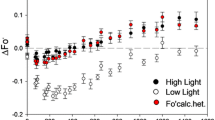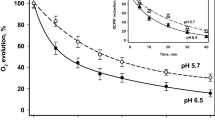Abstract
The thermoluminescence characteristics of functionally intact thylakoids and TRIS-washed BBY particles were studied under Cu(II) poisoned conditions. In thylakoids, both the A and B thermoluminescence bands corresponding to S3QA - and S2S3QB - charge recombinations, respectively showed specific responses to Cu(II) treatment. The amplitude of the B band was gradually decreased, which corresponds to the Cu(II) induced inactivation of TyrZ. The simultaneous stepwise shift in the peak position of the B band indicated, however, that S3QB - charge recombination is more resistant to Cu(II) poisoned conditions. The shifted peak position of the A band toward the higher temperature in Cu(II) treated thylakoids also showed a change in the redox span between the recombination partners generating the A band of the glow curve. The AT band due to the His+QA - recombination in TRIS-washed BBY particles was insensitive to Cu(II) addition indicating that Cu(II) did not affect either His+ or QA -. The unaffected intensity of the A and AT bands when Cu(II) inhibits TyrZ function favours the assumption of an alternative pathway in which functional TyrZ is not required. In addition, Cu-induced changes of the TL bands were compared to those produced by the Tyr and His modifiers NBD and DEPC, respectively. We obtained very similar results regarding TL bands by either adding NBD or Cu-poisoning in functional thylakoids. Regarding DEPC, the A and AT bands were abolished by increasing concentrations of the His modifier. This effect was associated with the decrease of the B band and its replacement by the Q band at around 0 °C. Comparing our data obtained by Cu, NBD and DEPC treatments, we have found a strong interrelation between His+ and S3 state. We assume that in some inhibitory conditions in the S3 state His is oxidized in place of Mn and this alternative pathway does not require functional TyrZ.
Similar content being viewed by others
References
Allakhverdiev SI, Klimov VV and Demeter S (1992) Thermoluminescence evidence for light-induced oxidation of tyrosine and histidine residues in manganese-depleted Photosystem II particles. FEBS Lett 297: 51–54
Arellano JB, Schröder WP, Sandmann G, Chueca A and Barón M (1994) Removal of nuclear contaminants and of non-specifically Photosystem II-bound copper from Photosystem II preparations. Physiol Plant 91: 369–374
Arellano JB, Lázaro JJ, López-Gorgé J and Barón M (1995) The donor side of PS II as the copper-inhibitory binding site. Photosynth Res 45: 127–134
Barón M, Arellano JB and López Gorgé J (1995) Copper and Photosystem II: A controversial relationship. Physiol Plant 94: 174–180
Berthold DA, Babcock GT and Yocum CA (1981) A highly resolved, oxygen-evolving Photosystem II preparation from spinach thylakoid membranes. FEBS Lett 134: 231–234
Berthomieu C and Boussac A (1995) Histidine oxidation in the S2 to S3 transition probed by FTIR difference spectroscopy in the Ca2+-depleted Photosystem II: Comparison with histidine radicals generated by UV radiation. Biochemistry 34: 1541–1548
Bohner H, Böhme H and Böger P (1980) Reciprocal formation of plastocyanin and cytochrome c-553 and the influence of cupric ions on photosynthetic electron transport. Biochim Biophys Acta 592: 103–112
Boussac A, Zimmermann JL, Rutherford AW and Lavergne J (1990) Histidine oxidation in the oxygen-evolving Photosystem-II enzyme. Nature 347: 303–306
Cedeño-Moldonado A and Swader JA (1972) The cupric ion as an inhibitor of photosynthetic electron transport in isolated chloroplasts. Plant Physiol 50: 698–701
Demeter S and Govindjee (1989) Thermoluminescence in plants. Physiol Plant 75: 121–130
Demeter S, Herczeg T, Droppa M and Horváth G (1979) Thermoluminescence characteristics of granal and agranal chloroplasts of maize. FEBS Lett 100: 321–324
Demeter S, Rózsa Z, Vass I and Sallai A (1985) Thermoluminescence study of charge recombination in Photosystem II at low temperatures. I. Characterization of the Zv and A thermoluminescence bands. Biochim Biophys Acta 809: 369–378
Deters DW, Racker E, Nelson N and Nelson H (1975) Partial resolution of the enzymes catalyzing photophosphorylation. XV Approaches to the active site of coupling factor I. J Biol Chem 250: 1041–1047
Droppa M and Horváth G (1990) The role of copper in photosynthesis. Crit Rev Plant Sci 9: 111–123
Droppa M, Horváth G, Vass I and Demeter S (1981) Mode of action of Photosystem II herbicides studied by thermoluminescence. Biochim Biophys Acta 638: 210–216
Ehrenberg L, Fedorcsák I and Solymosy F (1976) Diethyl pyrocarbonate in nucleic acid research. Progr Nucleic Acid Res Mol Biol 16: 189–261
Ford RC and Evans MCW (1983) Isolation of a PS II preparation from higher plants with highly enriched oxygen-evolution activity. FEBS Lett 160: 159–164
Haumann M, Drevenstedt V, Hundelt M and Junge W (1997) Photosystem II of green plants. Oxidation and deprotonation of the same component (histidine?) on S⇒ ⇒ S2 in chloride-depleted centers as on S2 ⇒ S3 in controls. Biochim Biophys Acta 1273: 237–250
Hedge U, Padhye S, Kovács L, Vozár A and Demeter S (1993) Modification of histidine residues of Photosystem II by diethyl pyrocarbonate inhibits the electron transfer between the primary (QA) and secondary (QB) quinone acceptors. Z Naturforsch 48c: 896–902
Horváth G (1986) Usefulness of thermoluminescence in herbicide research. Crit Rev Plant Sci 4: 293–310
Hsu BD and Lee JL (1988) Toxic effects of copper on Photosystem II centers inactive in plastoquinone reduction by fluorescence induction. Plant Physiol 87: 116–119
Inoue Y and Shibata K (1982) Thermoluminescence from photosynthetic apparatus. In: Govindjee (ed) Photosynthesis, Vol 1, pp 507–533. Academic Press, New York
Jegerschöld C, Arellano JB, Schröder WP, van Kan PJM, Barón M and Styring S (1995) Cu(II) inhibition of the electron transfer through Photosystem II studied by EPR spectroscopy. Biochemistry 34: 12747–12754
Joliot P and Joliot A (1981) Double photoreactions induced by a laser flash as measured by oxygen emission. Biochim Biophys Acta 638: 132–140
Koike H, Siderer Y, Ono TA and Inoue Y (1986) Assignment of themoluminescence A band to S3QA ? charge recombination: sequential stabilization of S3 and QA ? by a two-step illumination at different temperatures. Biochim Biophys Acta 850: 80–89
Králová K, Sersen F and Blahová M (1994) Effects of Cu(II) complexes on photosynthesis in spinach chloroplasts. Aqua(aryloxyacetato)copper(II) complexes. Gen Physiol Biophys 13: 483–491
Kramer DM, Roffey RA, Govindjee and Sayre RT (1994) The AT thermoluminescence band from Chlamydomonas reinhardtii and the effects of mutagenesis of histidin residues on the donor side of the Photosystem II D1 polipeptide. Biochim Biophys Acta 1185: 228–237
Ljungberg U, Akerlund HE and Andersson B (1986) Isolation and characterization of the 10 kDa and 22 kDa polypeptides from higher plant Photosystem II. Eur J Biochem 158: 477–482
Mohanty N, Vass I and Demeter S (1989) Copper toxicity affects Photosystem II electron transport at the secondary quinone acceptor (QB). Plant Physiol 90: 175–179
Ono TA and Inoue Y (1991) Biochemical evidence for histidine oxidation in Photosystem II depleted of the Mn-cluster for O2-evolution. FEBS Lett 278: 183–186
Renganathan M and Bose S (1989) Inhibition of primary photochemistry of Photosystem II by copper in isolated pea chloroplasts. Biochim Biophys Acta 974: 247–253
Renganathan M and Bose S (1990) Inhibition of Photosystem II activity by Cu(II) ion. Choice of buffer and reagent is critical. Photosynth Res 23: 95–99
Renger G, Gleiter HM, Haag E and Reifarth F (1993) Photosystem II: Thermodynamics and kinetics of electron transport from QA ? to QB (QB ?) and deleterious effects of copper (II). Z Naturforsch 48c: 234–240
Samson G, Morissette JC and Popovic R (1988) Copper quenching of the variable fluorescence in Dunaliella tertiolecta. New evidence for a copper inhibition effect on PS II photochemistry. Photochem Photobiol 48: 329–332
Samuelsson G and Öquist G (1980) Effects of copper chloride on photosynthetic electron transport and chlorophyll-protein complexes of Spinacea oleracea. Plant Cell Physiol 21: 445–454
Schioi Y, Tamai H and Sasa T (1978a) Inhibition of Photosystem II in green alga Ankistrodesmus falcatus by copper. Physiol Plant 44: 434–438
Schioi Y, Tamai H and Sasa T (1978b) Effects of copper on photosynthetic electron transport systems in spinach chloroplasts. Plant Cell Physiol 19: 203–209
Schröder WP, Arellano JB, Bittner T, Barón M, Eckert HJ and Renger G (1994) Flash induced absorption spectroscopy studies of copper interaction with Photosystem II in higher plants. J Biol Chem 269: 32865–32870
Singh DP and Singh SP (1987) Action of heavy metals on Hill activity and O2 evolution in Anacystis nidulans. Plant Physiol 83: 12–14
Vass I and Govindjee (1996) Thermoluminescence from the photosynthetic apparatus. Photosynth Res 48: 117–126
Vass I, Horváth G, Herczeg T and Demeter S (1981) Photosynthetic energy conversation investigated by thermoluminescence. Activation energies and half-lives of thermoluminescence bands of chloroplasts determined by mathematical resolution of glow curves. Biochim Biophys Acta 634: 140–152
Yruela I, Montoya G and Picorel R (1992) The inhibitory mechanism of Cu(II) on the Photosystem II electron transport from higher plants. Photosynth Res 33: 227–233
Yruela I, Alfonso M, Zarate IO, Montoya G and Picorel R (1993) Precise location of the Cu(II)-inhibitory binding site in higher plant and bacterial photosynthetic reaction centers as probed by light-induced absorption changes. J Biol Chem 268: 1684–1689
Yruela I, Gatzen G, Picorel R and Holzwarth R (1996) Cu(II)-inhibitory effect on Photosystem II from higher plants. A picosecond time-resolved fluorescence study. Biochemistry 35: 9469–9474
Author information
Authors and Affiliations
Rights and permissions
About this article
Cite this article
Horváth, G., Arellano, J.B., Droppa, M. et al. Alterations in Photosystem II electron transport as revealed by thermoluminescence of Cu-poisoned chloroplasts. Photosynthesis Research 57, 175–181 (1998). https://doi.org/10.1023/A:1006051815176
Issue Date:
DOI: https://doi.org/10.1023/A:1006051815176




